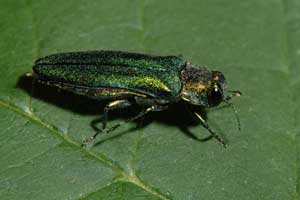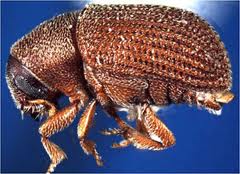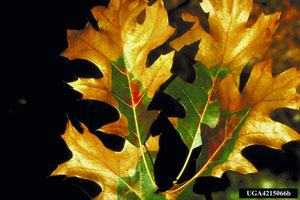







The emerald ash borer (EAB), Agrilus planipennis, is a very destructive insect pest of ash trees (Fraxinus spp.), the only known hosts of this borer in the United States. This exotic borer is a native of Asia with its natural range including China, Japan, Mongolia, Korea, the Russian Far East and Taiwan. It was first discovered in North America in southeast Michigan in June, 2002, although it was likely introduced at least 10 years earlier. It has since been found in the U.S. states of Ohio (2003), Indiana (2004), Maryland (2006), Illinois (2006), Pennsylvania (2007), West Virginia (2007), Wisconsin (2008), Missouri (2008) and Virginia (2008). It has also been found in the Canadian provinces of Ontario (2002) and Quebec (2008). In May 2009, it was discovered in St. Paul, Minnesota.
Elm Bark Beetle

Dutch elm disease (DED), is a fungal disease of elm trees which is spread by the elm bark beetle. Although believed to be originally native to Asia, the disease has been accidentally introduced into America and Europe,
where it has devastated native populations of elms which had not had the opportunity to evolve resistance to the disease.
The name Dutch elm disease refers to its identification in the Netherlands in 1921; the disease is not specific to the Dutch Elm hybrid.
Bark beetles often attack trees that are already weakened by disease, drought, smog, conspecific beetles or physical damage.
Healthy trees may put up defenses by producing resin or latex, which may contain a number of insecticidal and fungicidal compounds that can kill or injure attacking insects,
or simply immobilize and suffocate them with the sticky fluid. Under outbreak conditions, the sheer number of beetles can however overwhelm the tree's defences, and the results can be disastrous for the lumber industry.
The disease is spread in North America by two species of bark beetles (Family: Curculionidae, Subfamily: Scolytinae): the native elm bark beetle, Hylurgopinus rufipes, and the European Elm Bark Beetle, Scolytus multistriatus.
In Europe, while the aforementioned Scolytus multistriatus again acts as vector for infection, it is much less effective than the Large Elm Bark Beetle Scolytus scolytus.

Oak wilt, Is caused by the fungus Ceratocystis fagacearum (Bretz) Hunt, kills oak trees. It has been found in 21 States, with considerable damage occurring in the Midwest.
It was first recognized as an important disease in 1944 in Wisconsin (fig. 1) where, in localized areas (less than 100 acres (40.4 ha)), over half the oaks have been killed. Surveys in eight Wisconsin counties showed that about 11
percent of the annual growth increase of oak forests was offset by mortality caused by oak wilt.
In other States, the fungus kills thousands of trees; however, this loss is only a fraction of the total oak timber volume.
In West Virginia, for example, where predominately oak forests cover 70 percent of the land area, oak wilt losses average less than one tree per square mile each year. Oak wilt has also been reported in Texas - outside its main range.
© Davison Tree Service 2010